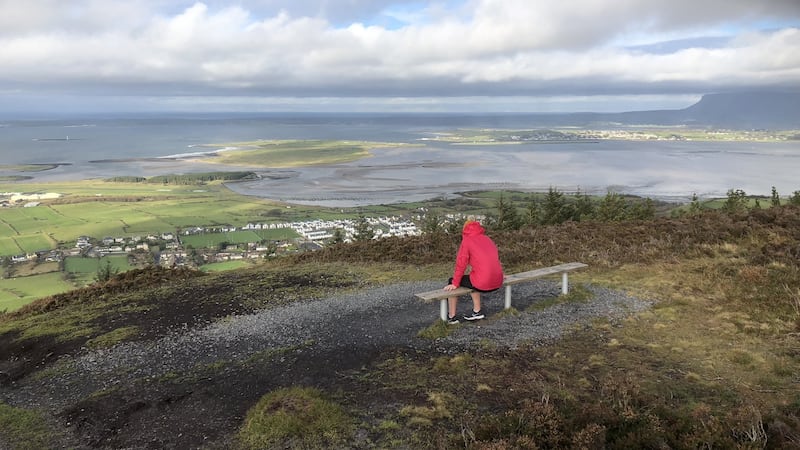Think Strandhill, Co Sligo, and golf and surfing spring to mind. But up behind the town, hiding above silent limestone ramparts, is a special place well worth a visit. It's a place made sacred by our Stone Age ancestors, and mythologised by their Iron Age descendants – and by a modern poet.
So pass up on chasing the little white ball or the big white wave, and take this trail to visit Queen Maeve in her resting place on the summit of Knocknarea. Legend has it that she was interred, in full battle gear, within the stones of the most dramatic tumulus in Ireland, at least 3,500 years after its construction by our Neolithic ancestors. We don't know what other secrets are inside that undisturbed summit tumulus, so bring your imagination with you to this unique place.
Maeve's supposed burial site is described in the excellent panels for this trail and area as a place "where land meets sky", or more poetically by WB Yeats in Red Hanrahan's Song about Ireland:

“The wind has bundled up the clouds high over Knocknarea
And thrown the thunder on the stones for all that Maeve can say.”
These stones were gathered together more than 5,000 years ago; in the meantime they have felt that one-in-5,000-year storm and, saving another over-topping new ice sheet, they will grace that hill for many, many more thousands of years.
Park sensitively in or near the car park of the Sligo Rugby Football Club outside Strandhill, appropriately volunteering a few euro for the privilege, and ascend this newly-constructed trail, starting just across the road. The trail is well made: an initial level section soon becomes a steep but stepped gravel stairway, then turns right on to a short contouring “balcony” route, and soon left on to a lovely forest-sheltered boardwalk. This takes you up to one of the best-situated benches in the northwest.
Sit awhile here and watch the slow roll of the famous Strandhill surfing waves and just take in the vista of Rosses Point, Ben Bulben and, away to the north, the long line of Slieve League across Donegal Bay.
The path here reverts to gravel, traverses the heathery plateau and enters what the trail’s panels appropriately term “a sacred place” deserving of respect for the “people of the area” who are buried in the many Neolithic tombs there – and that respect must include not climbing the tumulus and adding to its problems of slumping. Come back the way you came, and on your right note the hollow from which, archaeologists suggest, stones were quarried and carried and piled up to make the second biggest Neolithic tumulus in Ireland.
We came on a bright, rain-free November day of gentle southwesterly winds, making for a lovely visit to a magical place. And later, down on the Strandhill beachfront, the fish cakes of the Strand Bar, followed by the spectacular ice-cream of Mammy Johnson’s, were magical for us too.
Walk for the Weekend: Queen Maeve's Trail, Strandhill, Co Sligo
Start/Finish: Opposite Sligo Rugby Club outside Strandhill on R292 from Sligo town.
Suitability: Easy to moderate; good runners, but care needed on stepped boardwalk.
Effort: about 280m of climbing, 2 hours.
Facilities: cafes and restaurants on beachfront.










